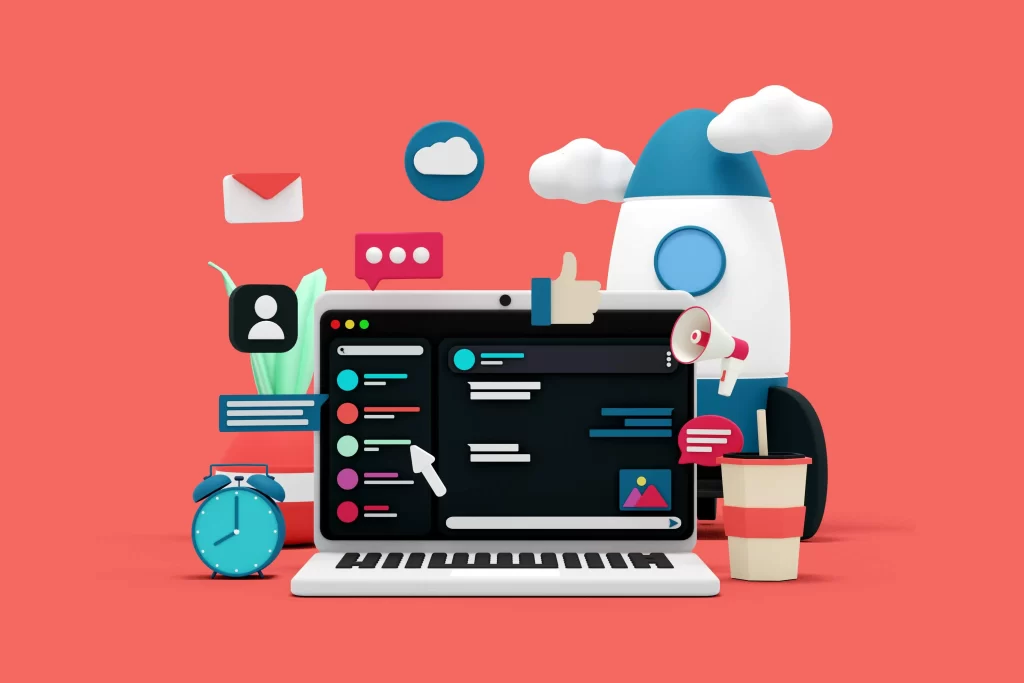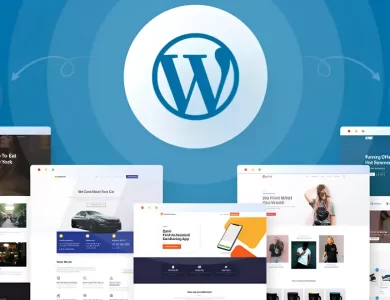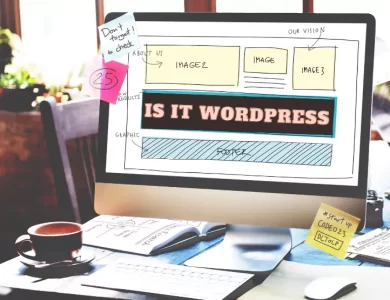Web Design: Blending Art and Science for Stunning Results
The Art and Science of Web Design: Crafting Beautiful and Functional Website

In today’s digital era, the design of a website is pivotal to a brand’s success. A well-crafted website serves as the digital storefront for businesses, offering a platform to connect with potential customers, showcase products or services, and build a lasting brand identity. Web design encompasses more than just visual appeal; it involves creating a seamless and engaging user experience that aligns with business objectives.

Understanding the Impact of Web Design
Web design is a blend of aesthetics and functionality that influences how users interact with a website. It affects user perceptions, engagement levels, and overall satisfaction. An effective web design enhances user experience (UX) and contributes to achieving business goals.
A. Building Trust and Credibility
A well-designed website establishes credibility and builds trust with users. Key factors contributing to a professional image include:
- Design Consistency: Consistent use of colors, fonts, and design elements helps create a cohesive brand identity. It reinforces brand recognition and professionalism.
- High-Quality Imagery: Using high-resolution images and graphics enhances the visual appeal of the site and conveys a sense of quality. Stock photos should be used sparingly, with original or branded images preferred.
- Clear Branding: Prominent display of brand elements such as logos and taglines helps users immediately identify the brand and understand its core message.
B. Enhancing User Engagement
Engaging users is crucial for retaining visitors and encouraging interaction. Strategies to enhance engagement include:
- Interactive Features: Incorporating interactive elements like quizzes, surveys, and animations can make the website more engaging and provide a memorable user experience.
- Multimedia Content: Using videos, infographics, and interactive media can make content more appealing and easier to understand. Multimedia elements should complement the written content and enhance user engagement.
- Personalization: Tailoring content and recommendations based on user behavior and preferences can create a more personalized experience and increase user satisfaction.
C. Driving Business Goals
Effective web design supports business objectives by guiding users toward desired actions. Key strategies include:
- Strategic CTAs: Placing call-to-action (CTA) buttons in prominent locations and using compelling language encourages users to take specific actions, such as making a purchase or signing up for a newsletter.
- Conversion Optimization: Designing landing pages with a clear focus on conversion goals helps drive user actions. This includes using persuasive messaging, minimizing distractions, and ensuring a smooth user flow.
- Analytics and Tracking: Implementing analytics tools allows businesses to monitor user behavior, track conversions, and measure the effectiveness of design elements. Data-driven insights can inform ongoing design improvements.

Key Principles of Effective Web Design
Effective web design is grounded in several core principles that ensure a positive user experience and support business objectives.
A. User-Centric Approach
A user-centric design focuses on the needs and preferences of the target audience. Key aspects include:
- User Research: Conducting research to understand user demographics, preferences, and pain points helps inform design decisions. Methods include surveys, interviews, and user testing.
- User Personas: Creating detailed user personas representing different segments of your audience helps tailor design elements to meet their specific needs and expectations.
- Usability Testing: Regular testing with real users identifies usability issues and areas for improvement. This ensures that the design meets user needs and provides a seamless experience.
B. Visual Design Elements
Visual design elements contribute to the overall look and feel of the website. Key considerations include:
- Color Scheme: The choice of colors impacts user emotions and brand perception. A well-chosen color palette should align with the brand’s identity and enhance readability.
- Typography: Selecting appropriate fonts and maintaining consistency in typography improves readability and visual hierarchy. Combining different font styles can create emphasis and guide users through content.
- Imagery and Graphics: Using high-quality, relevant images and graphics enhances visual appeal and supports the content. Graphics should be optimized for web use to ensure fast loading times.
C. Functional Design Aspects
Functional design ensures that a website is practical and easy to use. Key aspects include:
- Navigation: A clear and intuitive navigation structure helps users find information quickly. This includes a well-organized menu, search functionality, and logical page hierarchy.
- Mobile Responsiveness: With increasing mobile device usage, a responsive design that adapts to various screen sizes ensures a consistent experience across devices.
- Loading Speed: Fast loading times improve user satisfaction and search engine rankings. Techniques to enhance speed include image optimization, code minification, and caching.

Content Strategy and Its Role
Content is a crucial component of web design that complements visual elements and enhances user experience. An effective content strategy ensures that the website delivers valuable and relevant information.
A. Crafting Compelling Content
- Clear Messaging: Content should convey the brand’s message clearly and concisely. Avoid jargon and focus on delivering information that resonates with the audience.
- Engaging Formats: Utilizing various content formats, such as blog posts, videos, and infographics, keeps users engaged and provides diverse ways to consume information.
- CTAs: Effective CTAs guide users towards desired actions. They should be strategically placed, use action-oriented language, and stand out visually.
B. SEO and Content Optimization
Search engine optimization (SEO) is essential for improving a website’s visibility in search engine results. Key SEO practices include:
- Keyword Research: Identifying and using relevant keywords helps attract organic traffic and improve search rankings. Keywords should be naturally integrated into content, headings, and meta descriptions.
- On-Page SEO: Optimizing on-page elements, such as titles, meta descriptions, and headers, enhances search engine visibility and improves user experience.
- Regular Updates: Keeping content fresh and updated signals to search engines that the site is active and relevant. Regularly publishing blog posts or updating existing content can boost SEO performance.

Emerging Trends in Web Design
Staying current with emerging trends helps ensure that a website remains modern and relevant. Key trends to watch include:
- Minimalist Design: Emphasizing simplicity and functionality, minimalist design removes unnecessary elements to create a clean and focused user experience. This trend highlights essential content and improves usability.
- Interactive Elements: Adding animations, hover effects, and interactive features can enhance user engagement and make the site more dynamic. Interactive elements should be used judiciously to avoid overwhelming users.
- Voice Search Optimization: As voice-activated devices become more prevalent, optimizing content for voice search can improve accessibility and attract a broader audience. This includes focusing on natural language and conversational queries.
- Artificial Intelligence (AI): AI technologies, such as chatbots and personalized recommendations, can enhance user interactions and provide a more tailored experience. AI-driven tools can automate tasks and improve efficiency.
Web design can be seen as both an art and a science. Each perspective highlights different aspects of the discipline, reflecting its complexity and multifaceted nature.
Is Web Design An Art Or A Science?

Web design can be seen as both an art and a science. Each perspective highlights different aspects of the discipline, reflecting its complexity and multifaceted nature.
1-) Web Design as an Art
- Creativity and Aesthetics: Web design involves artistic elements such as layout, color schemes, typography, and visual hierarchy. Designers use creativity to craft aesthetically pleasing interfaces that attract and engage users. Artistic choices influence how users perceive and interact with the site, contributing to a positive brand image and user experience.
- Visual Storytelling: Effective web design often tells a story through visual means. Designers use imagery, graphics, and design elements to convey messages and evoke emotions. This storytelling aspect is an art form, as it requires an understanding of visual communication and an ability to translate concepts into compelling designs.
- User Experience (UX) Design: While UX design incorporates scientific principles, it also relies on artistic intuition. Designers create intuitive navigation, interactive elements, and engaging layouts to ensure a seamless user experience. The balance between form and function requires a blend of artistic vision and practical considerations.
2-) Web Design as a Science
- User-Centric Principles: Web design follows principles rooted in psychology and behavioral science. Understanding how users interact with websites, what drives their behavior, and how they process information informs design decisions. Designers use this knowledge to create interfaces that are intuitive, efficient, and effective.
- Technical Implementation: The technical side of web design involves coding, responsiveness, and performance optimization. Knowledge of HTML, CSS, JavaScript, and other technologies is essential for translating design concepts into functional websites. Technical skills ensure that designs work across different devices and browsers and perform well.
- Data-Driven Design: Science plays a role in web design through data analysis and testing. User research, A/B testing, and analytics provide insights into how design changes impact user behavior and site performance. This data-driven approach allows designers to make informed decisions and continuously improve the website based on empirical evidence.
3-) The Intersection of Art and Science
Web design is most effective when it integrates both artistic creativity and scientific principles. The art of design creates visually appealing and engaging experiences, while the science ensures that these experiences are functional, user-friendly, and based on data-driven insights.
- Design Iteration: The process of designing, testing, and refining involves both artistic and scientific approaches. Designers create prototypes and use feedback to make iterative improvements, balancing aesthetic goals with practical considerations.
- Holistic Approach: A successful web design approach considers both the artistic aspects of creating a beautiful, engaging interface and the scientific aspects of ensuring functionality, usability, and performance. This holistic approach leads to designs that not only look good but also deliver a positive user experience.
I believe that web design is a blend of art and science. It requires creativity to create visually appealing designs and scientific principles to ensure functionality and user satisfaction. The most effective web designs harmonize these elements to create websites that are both beautiful and practical.

Who is a Web Designer?
A web designer is a professional who creates and arranges the visual elements of websites. Their role encompasses various aspects of web design, including layout, color schemes, typography, graphics, and overall user experience (UX). Web designers focus on how a website looks and how users interact with it, aiming to create aesthetically pleasing and functional digital experiences.

Key Responsibilities of a Web Designer
- Visual Design: Web designers are responsible for crafting the visual appearance of a website. This includes selecting color schemes, fonts, and images that align with the brand’s identity and appeal to the target audience. They ensure that the design is attractive and engaging.
- Layout and Structure: They design the layout and structure of web pages, determining how content is organized and presented. This involves creating wireframes and prototypes to establish the placement of text, images, and interactive elements.
- User Experience (UX): Web designers work to ensure that the website provides a positive user experience. This includes designing intuitive navigation, clear calls-to-action (CTAs), and interactive elements that enhance usability and user satisfaction.
- Responsive Design: They create designs that work well across different devices and screen sizes. Responsive design ensures that the website is accessible and functional on desktops, tablets, and smartphones.
- Graphic Design: Web designers often create or select visual assets such as logos, icons, and images. They may use graphic design tools to produce custom graphics that enhance the website’s look and feel.
- Collaboration: Web designers frequently collaborate with other professionals, including web developers, content creators, and marketing teams. They work together to ensure that the design is implemented correctly and meets the project’s goals.
- Testing and Optimization: They may be involved in testing the website to identify and resolve design-related issues. This includes checking for compatibility across different browsers and devices and ensuring that the design performs well in terms of speed and functionality.

Skills and Qualifications
- Design Software Proficiency: Web designers use various design tools and software, such as Adobe Creative Suite (Photoshop, Illustrator), Sketch, Figma, and Adobe XD. Proficiency in these tools is essential for creating high-quality designs.
- Understanding of Web Technologies: While not always required to code, web designers should have a basic understanding of web technologies like HTML, CSS, and JavaScript. This knowledge helps them create designs that can be effectively implemented by developers.
- Creativity: Creativity is crucial for web designers as they need to come up with innovative design solutions that capture the brand’s essence and engage users.
- Attention to Detail: A keen eye for detail ensures that designs are visually appealing and free from errors. This includes ensuring consistency in design elements and adhering to design standards.
- User-Centered Design: Understanding user behavior and preferences is essential for designing websites that meet users’ needs and provide a positive experience.
- Communication Skills: Effective communication is important for collaborating with clients and team members. Web designers need to articulate their design choices and understand client requirements.

Types of Web Designers
- UI (User Interface) Designers: Focus on designing the visual layout and interactive elements of a website. They concentrate on how the site looks and how users interact with it.
- UX (User Experience) Designers: Specialize in creating a positive user experience by focusing on usability, user flow, and overall functionality. They conduct research and testing to ensure the website meets user needs.
- Graphic Web Designers: Combine graphic design skills with web design to create visual elements like logos, banners, and icons that enhance the website’s visual appeal.
- Responsive Web Designers: Emphasize creating designs that adapt to various devices and screen sizes, ensuring that the website is accessible and functional across different platforms.
Web design is a multifaceted discipline that combines art and science to create engaging digital experiences. By focusing on user needs, visual appeal, and content strategy, businesses can design websites that attract visitors, increase engagement, and achieve business goals. As technology continues to evolve and user expectations continue to change, staying informed about the latest trends and best practices in web design will help you create effective and impactful online experiences.
For my other articles please click on the link 👉 Algorithm Man
| Category | Description | Key Considerations |
|---|
| Design Principles | Fundamental concepts guiding the visual and functional aspects of web design. | Balance, contrast, alignment, repetition, proximity. |
| User Experience (UX) | Focuses on how users interact with a website and their overall experience. | Usability, accessibility, user flow, feedback mechanisms. |
| User Interface (UI) | Refers to the visual elements that users interact with on a website. | Layout, buttons, icons, forms, and navigation elements. |
| Responsive Design | Designing websites to work well on a variety of devices and screen sizes. | Fluid grids, flexible images, media queries. |
| Typography | The style and appearance of text on a website. | Font choices, readability, hierarchy, and spacing. |
| Color Theory | The use of colors to enhance design and convey messages. | Color harmony, contrast, and psychological impact. |
| Navigation | How users move through a website to find information. | Menu structure, breadcrumbs, search functionality. |
| Content Strategy | Planning and managing website content to meet user needs and business goals. | Content creation, organization, and optimization. |
| Graphics and Imagery | The visual elements used to enhance the design. | Image quality, relevance, optimization, and consistency. |
| Performance | How efficiently a website operates in terms of speed and responsiveness. | Loading times, optimization techniques, caching. |
| SEO (Search Engine Optimization) | Techniques used to improve a website’s visibility in search engine results. | Keyword integration, meta tags, and on-page optimization. |
| Accessibility | Designing websites to be usable by people with various disabilities. | Alt text for images, keyboard navigation, color contrast. |
| Testing and Analytics | Methods to assess and improve website performance and user experience. | A/B testing, user feedback, analytics tools. |
| Maintenance | Ongoing updates and improvements to ensure a website remains functional and relevant. | Regular updates, bug fixes, and content updates. |





